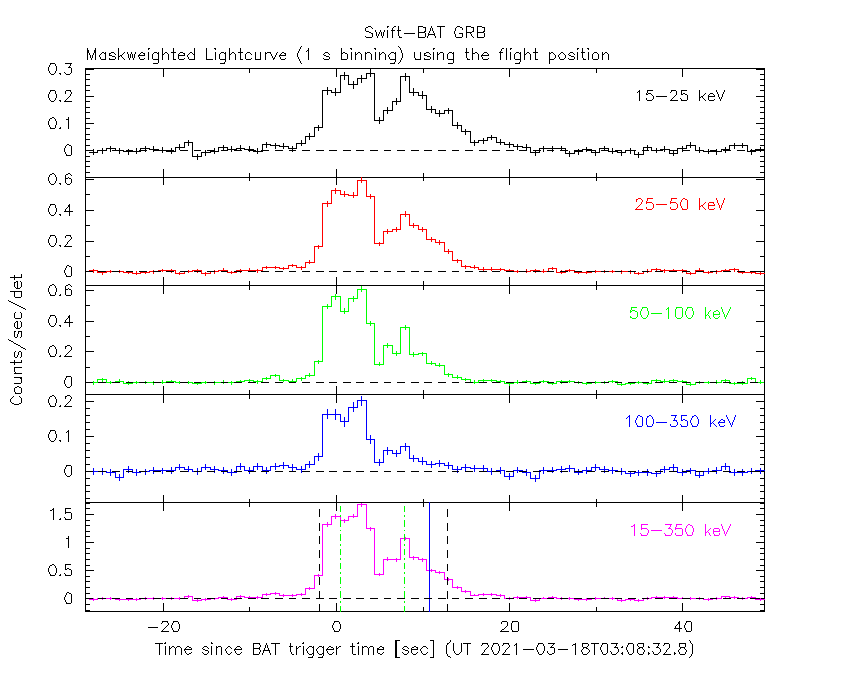
E. Troja (NASA/GSFC, UMCP) and M.H. Siegel (PSU) for the Swift team
At 03:08:33 UT, the Swift Burst Alert Telescope (BAT) triggered and located GRB 210318B (trigger=1037335) (Troja et al. GCN Circ. 29663). Swift slewed immediately to the burst. Table 1 contains the best reported positions from Swift.
Table 2 is a summary of GCN Circulars about this GRB from observatories other than Swift.
Standard analysis products for this burst are available at https://gcn.gsfc.nasa.gov/swift_gnd_ana.html.
As reported by Stamatikos et al. (GCN Circ. 29666),
the BAT ground-calculated position is RA, Dec = 264.228, -35.823 deg which is RA(J2000) = 1
The mask-weighted light curve (Figure 1) shows a multi-peak structure running from ~T-4 s to T+15 s.
The time-averaged spectrum from T-11.22 to T+19.42 s is best fit by a power law with an exponential cutoff.
This fit gives a photon index 1.10 ± 0.13, and
The results of the batgrbproduct analysis are available at https://gcn.gsfc.nasa.gov/notices_s/1037335/BA/.
We have analysed 6.1 ks of XRT data for GRB 210318B, from 52 s to 76.0 ks after the BAT trigger. The data comprise 584 s in Windowed Timing (WT) mode (the first 9 s were taken while Swift was slewing) with the remainder in Photon Counting (PC) mode.
The light curve (Figure 2) can be modelled with an initial power-law decay with an index of α=0.70 ± 0.03, followed by a break at T+597 s to an α of 1.45 (+0.08, -0.06).
A spectrum formed from the WT mode data can be fitted with an absorbed power-law with a photon spectral index of 1.78 ± 0.09. The best-fitting absorption column is 1.43 ± 0.13 x 1
A summary of the PC-mode spectrum is thus:
Total column: 1.6 ± 0.4 x 1
Galactic foreground: 7.1 x 1
Excess significance: 4.0 σ
Photon index: 1.69 (+0.27, -0.25)
The results of the XRT team automatic analysis are available at http://www.swift.ac.uk/xrt_products/01037335.
The Swift/UVOT began settled observations of the field of GRB 210318B 70 s after the BAT trigger
(Siegel and Troja GCN Circ. 29695).
No optical afterglow consistent with the XRT position (Troja et al. GCN Circ. 29663) is detected in the initial UVOT exposures.
Table 3 gives preliminary
magnitudes using the UVOT photometric system
(Breeveld et al. 2011, AIP Conf. Proc., 1358, 373).
No correction has been made for the expected extinction in the Milky Way
corresponding to a reddening of

Figure 1. The BAT
mask-weighted light curve in the four individual and total
energy bands. The units are counts

Figure 2. The XRT light curve.
Any data from a crosshatched region are not included in the fit.
| RA (J2000) | Dec (J2000) | Error | Note | Reference |
|---|---|---|---|---|
| 1 |
-35°49'19.2" | 3.5" | XRT-final | UKSSDC |
| 1 |
-35°49'19.2" | 3.5" | XRT-initial | Troja et al. GCN Circ. 29663 |
| 1 |
-35°49'21.4" | 1.0' | BAT-refined | Stamatikos et al. GCN Circ. 29666 |
| Band | Authors | GCN Circ. | Subject | Observatory | Notes |
|---|---|---|---|---|---|
| Optical | Hosokawa et al. | 29675 | MITSuME Okayama optical upper limits | MITSuME Okayama | upper limits |
| Gamma-ray | Svinkin et al. | 29664 | Konus-Wind detection | Konus-Wind | Duration=~14 seconds Fluence=3.83(-0.44,+0.50)x1 |
| Gamma-ray | Malacaria and Meegan | 29668 | Fermi GBM detection | Fermi GBM | Fluence=2.537±0.393x1 (1.2 percentile for long GRBs) |
| Filter | Exp(s) | Mag | ||
|---|---|---|---|---|
| whit |
70 | 219 | 147 | >20.0 |
| 282 | 532 | 246 | >20.1 | |
| white | 70 | 1357 | 373 | >20.9 |
| v | 612 | 1406 | 97 | >18.2 |
| b | 538 | 1500 | 92 | >19.1 |
| u | 282 | 1479 | 324 | >20.1 |
| w1 | 661 | 1455 | 97 | >18.8 |
| m2 | 1066 | 1430 | 58 | >19.3 |
| w2 | 588 | 1382 | 97 | >19.0 |
Table 3. UVOT observations reported by Siegel and Troja (GCN Circ. 29695). The start and stop times of the exposures are given in seconds since the BAT trigger. The preliminary 3-σ upper limits are given. No correction has been made for extinction in the Milky Way.
March 23, 2021